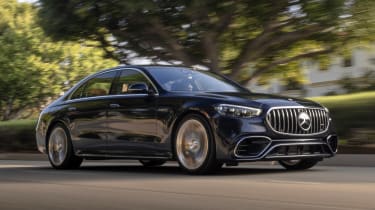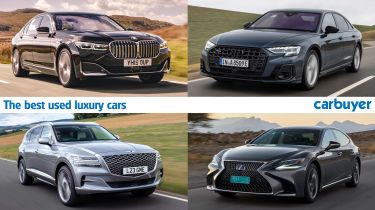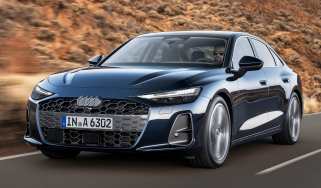Mercedes S-Class saloon review


If you fancy a car that’s a cut above the typical family SUV or saloon but you don’t have six figures to spend, then a used luxury car could be your cut-price ticket to automotive opulence. The used car market is full of premium-badge bargains, but discerning a good deal from a money-pit can be tricky.
Our guide covers the best used luxury cars you can find. All are suitably comfortable, powerful and technology-laden, while depreciation has resulted in serious savings over a brand-new alternative. Be warned, just because a luxury car is cheap to buy, doesn’t mean it’ll be cheap to run – some will have higher-than-average fuel consumption, and insurance and service costs can be more expensive. If that’s a trade-off you’re willing to make, then keep reading to find out which used luxury car you should buy.
Check out our guides to the best luxury SUVs and best luxury cars, or keep reading to see what we think are the best used luxury cars to buy now.
The Mercedes S-Class has long been regarded as the default luxury car for those with plenty of cash. The three-pointed-star on the bonnet carries plenty of prestige and kerb appeal, while the opulent interior is more akin to a first-class aeroplane cabin than it is a car. The S-Class is offered in two lengths: short and long wheelbase (the distance between the front and rear wheels). Even short wheelbase cars are luxurious and have plenty of space, but long wheelbase models often boast the luxury of electrically-reclining rear seats – fun to show off, but only useful if you’ll spend most of your time being chauffeured.
The current-generation S-Class appeared in 2021, yet older models offer the best value for money on the used market. These are often half the price (or less) than they were when new and have an interior that still feels modern today, thanks to the slick dual-screen infotainment system that comes as standard on all models. We recommend opting for one of the diesel versions, as these are quiet out on the road and return respectable MPG figures, despite the S-Class’ undeniable bulk.
BMW’s rival to the S-Class, the 7 Series has stood toe-to-toe with its Mercedes counterpart for decades. The current model, released in 2022, arrived with enough tech to rival NASA, but the last-generation car still holds up today with an impressive interior and an equally polarising front grille.
Whether you love or hate the design, it’s hard to deny the impressive capability of the 7 Series; one minute you can be comfortably wafting along the motorway and the next attacking a B-road with nearly as much finesse as a much smaller sports saloon. The 7 Series is pretty much as close to the ‘Ultimate Driving Machine’ as big luxury cars get.
On the inside, the BMW feels suitably premium, with plenty of luxurious leathers, wood and metal trim. All models benefit from BMW’s slick iDrive system, which on newer cars can be operated with either the touchscreen or an intuitive rotary dial. As you’d expect from a car of this calibre, standard equipment is strong with things such as a high-end stereo, adaptive LED headlights, a powered tailgate and much, much more.
Luxury cars no longer have to conform to traditional saloon proportions – in fact, the majority on sale today are SUVs, and the Porsche Cayenne is one of the best. Regarded by many as the pioneer of the recent SUV craze, the Cayenne is as equally luxurious as it is sporty, combining Porsche’s famous handling characteristics with a roomy and well-appointed interior.
As newer Cayennes have grown faster and more capable, their price tags have crept up, too. However, depreciation is your friend on the used market, and there are plenty of deals to be found if you’re happy driving a car that’s a few years old. Previous-generation Cayennes came with a range of engines, including petrol, plug-in hybrid and diesel, while the current car – released in 2018 – has never been sold with the latter. All are great to drive, but be warned that petrol models are relatively thirsty.
If you prefer a more traditional take on a luxury car than a swanky SUV, then the Audi A8 is a solid choice. The A8 is far from traditional in terms of tech, however, as the slick dual-screen infotainment setup remains one of the most impressive units in the car industry, despite first appearing in 2017. Its luxurious interior may not have the same wow factor as the equivalent S-Class, but it still feels exquisitely built and is arguably more tasteful in its restrained nature.
Just like the Merc, the A8 is available in both short wheelbase and long-wheelbase ‘L’ form. All versions of the A8 come well-equipped with the aforementioned infotainment system, LED headlights, adaptive air suspension, electrically adjustable and heated front seats with memory, plus a reversing camera. There’s also a range of engines from the 281bhp 50 TDI diesel to the muscular 563bhp V8 in the sporty S8 model. Depreciation hasn’t been kind to the A8, but that makes it an even better used deal – you can pick up a nice example of a current-generation model for not much more than a new Skoda Superb.
It has become common to associate European cars with luxury and those from Japan with affordability. The Lexus LS stands in opposition to this stereotype as one of the very few luxury cars to come from the Land of the Rising Sun. It shares its platform with the Toyota Crown, a less-expensive full-size saloon that is only sold in Japan; however, the Lexus feels just as luxurious as any German rival, with a striking exterior design and an avant-garde interior.
As has come to be expected of Lexus cars in recent years, the LS is only available with a hybrid powertrain. In this case, it’s a 3.5-litre six-cylinder engine that’s paired with an electric motor. It’s smooth and muscular enough, but the real selling point is the claimed efficiency of 39.7mpg. While this is not quite on the level of diesel cars, it's an impressive figure for something that’s this big and essentially petrol-powered. Lexus is highly regarded for the reliability of its cars, too – a common pitfall for other used luxury cars.
Sporty coupes aren’t necessarily the first thing you think of when mentioning ‘luxury cars’, but the BMW 8 Series certainly fits the bill thanks to its premium badge, luxurious interior, powerful engines and hefty price tag. Inside, the 8 Series’ material quality matches that of the 7 Series saloon, while its smaller size and sportier styling will appeal to those who don’t quite need the acres of space that car provides.
Buyers can choose from three bodystyles: coupe, convertible and Gran Coupe, the latter being a swoopy four-door saloon. The flagship BMW is also available in either standard 8 Series or sporty M8 guise. However, even the entry-point into the range, the 840i, uses a powerful 328bhp six-cylinder petrol engine. This can do 0-62mph in just 5.2 seconds and is more than enough to make use of the car’s finely tuned handling.
Like many cars on this list, buying a one or two year old model will save you a chunk of cash, but a search of the used market also reveals that many dealers are offering substantial savings on pre-registered or nearly-new examples of the 8 Series – sometimes exceeding £20,000.
When it hit the market in 2015, the second-generation Volvo XC90 was revolutionary for the Swedish brand in terms of design. The XC90 is arguably one of the best looking large SUVs on sale, with its distinctive ‘Thor’s hammer’ headlamps a particular design highlight. On the inside, the Volvo is suitably Scandinavian with a minimalist layout, few physical buttons, a portrait-style touchscreen and some of the most comfortable seats in the business.
Volvo offers the XC90 with a variety of engines to suit many buyer's needs. We’d stay away from any of the petrol units as they are relatively thirsty and don’t quite suit the XC90’s relaxed driving style. The sweet spot in the range is the 234bhp B5 diesel engine, as this offers a good balance of performance and economy. Another solid option is the plug-in hybrid XC90 Recharge model, which offers up to 43 miles of electric-only range – although these cars are usually more expensive to buy than the equivalent diesel.
While most of the cars on this list tend to lose a significant portion of their value in the first few years, the Porsche Panamera is different as used examples typically remain close to the car’s original sale price. This means that while you’ll pay a premium to get behind the wheel, you shouldn't lose a lot of money when it’s time to sell. These strong residuals stem from Porsche’s rock solid reputation for prestige, performance and premium build-quality – all things the Panamera offers in spades.
The latest pre-facelift version of the Porsche Panamera was available in two body styles: a sleek hatchback and a practical Sport Turismo ‘estate’. Porsche offers a range of engine choices in the Panamera, from the top-of-the-range Turbo S, to the 4S E-Hybrid with its 33 miles of pure-electric range. Whichever model you choose, however, the Panamera is quick to disguise its large dimensions out on the road, driving just as well as any Porsche.
For many car buyers, the Genesis name remains unfamiliar, yet the GV80 makes an excellent left-field choice in the used luxury car market. As the premium spin-off brand from Hyundai, the GV80 was its first attempt at an SUV, appearing in 2020. While sales numbers have never been able to match those of its German rivals, you can still find several available on the used market, and we doubt you’ll spot another one on UK roads very often.
Exclusivity aside, the GV80 performs admirably as a BMW X5 or Audi Q7 rival. The cabin feels as premium as it looks, with swathes of leather and wood surrounding the driver. Tech is up to scratch, too, the big 14.5-inch central screen performing infotainment duties alongside a digital driver’s display. The SUV body translates to bags of passenger and cargo room, making the GV80 a very usable family luxury car. Reliability shouldn’t be an issue either – parent-brand Hyundai often performs well in our annual Driver Power surveys, coming 16th out of 35 brands in the most recent results.
The Range Rover is one of the most popular luxury cars in the world, and is a particular hit with the rich and famous. Often seen patrolling the streets of London’s upmarket Mayfair, the Range Rover features a palatial interior that’s marked by a luxuriously minimalist design and plenty of expensive-feeling trim. The infotainment system on older models can be a tad slow to respond, but cars built after 2020 use JLR’s snappier PIVI Pro system.
What truly defines the Range Rover is its near-unbeatable off-road capability. All models come equipped with four-wheel-drive, while the Terrain Response system can adjust the drivetrain in order to provide optimum grip on slippery surfaces. This feature even includes a wading mode, which can make sure you don’t surpass the SUV’s impressive 900mm maximum wading depth.
Significant depreciation has made the Range Rover a tempting contender on the used car market – just make sure to get an insurance quote before making a purchase, as its popularity with car thieves has seen premiums skyrocket.
Luxury cars sit at the pinnacle of the automotive world and set the bar for cutting-edge features and technology. Typically a manufacturer’s flagship model, these cars boast suitably opulent interiors, cutting-edge technology and muscular powertrains; everything well-heeled buyers expect.
For example, the latest Mercedes S-Class has an ‘augmented reality sat-nav’ feature that utilises a suite of cameras and systems to project directions onto the road ahead via the infotainment screen. Speaking of screens, the new BMW i7 has a giant 31-inch ‘Theatre Screen’ display for rear passengers. Air suspension systems are practically par for the course today, cushioning passengers from any untoward bumps in the road.
All this innovation doesn’t come cheap, so luxury cars are understandably very expensive. Many cost over £100,000 when new but are prone to breathtaking depreciation, meaning they lose a lot of their initial value in a short space of time. This is good for used buyers, as you can often buy a car that’s only a couple of years old for significantly less than it cost brand new.
However, any buyer of a used luxury car must exercise caution when looking for a premium-badge bargain. All that tech the manufacturers tend to cram into their high-end cars is at risk of going wrong after a few years, potentially leaving the used car buyer with an eye-watering repair bill if the car is no longer covered by the manufacturer’s warranty.
As with any used car purchase, it’s vital to check the important facts – service history, number of owners, any reports of damage and so on. It’s also worth checking whether the car was used as a luxury taxi, airport shuttle car or chauffeur vehicle in a previous life – not necessarily a bad thing, but be aware that some cars will have lived harder lives than others. We always recommend thoroughly test driving a used car before purchase, as well as carrying out an HPI check.
Looking for something luxurious that isn’t large? Check out our list of the top 10 best small luxury cars...



